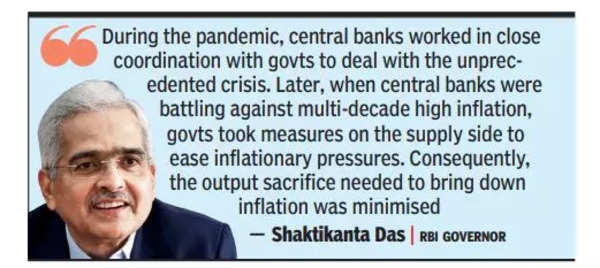MUMBAI: Coordination between RBI and govt has helped bring down the trade-off between battling inflation and growth, RBI governor Shaktikanta Das said.
RBI has steadfastly maintained that there is no trade-off between growth and inflation in the long term, as low inflation is a prerequisite for sustainable growth. However, its monetary action to curb inflation, besides dampening demand, also has an immediate impact on growth.

According to Das, experiences in the aftermath of the pandemic have shown how coordinated monetary and fiscal policies can have better economic outcomes.
“During the pandemic, central banks worked in close coordination with govts to deal with the unprecedented crisis. Later, when central banks were battling against multi-decade high inflation, govts took measures on the supply side to ease inflationary pressures. Consequently, the output sacrifice needed to bring down inflation was minimised,” said Das. He was delivering the First Himalaya Shumsher Memorial Lecture at Nepal Rastra Bank in Kathmandu on Tuesday.
To soften the impact of the lockdown, RBI had infused liquidity to the tune of over Rs 5.5 lakh crore, which reduced the stress on businesses. Subsequently, when RBI was forced to hike interest rates in 2022 to cool inflation, govt took a number of measures to cool commodity prices that were seeing price spikes.
In his speech, Das said that the model for central banking has changed over the last decade. While earlier central banks were focused on price stability as a sole objective, they now have a broader mandate that includes sustained growth and financial stability in addition to price stability. “The trade-off between price stability and growth emerges when the pursuit of price stability entails large growth sacrifice,” Das added.
